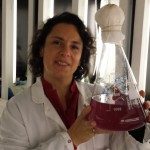Lien vers Pubmed [PMID] – 33711249
Lien vers HAL – pasteur-03261377
Lien DOI – 10.1016/j.cub.2021.02.039
Curr Biol 2021 May; 31(10): 2203-2213.e5
The midbody at the center of the intercellular bridge connecting dividing cells recruits the machinery essential for the final steps of cytokinesis.1-5 Successive abscission on both sides of the midbody generates a free midbody remnant (MBR) that can be inherited and accumulated in many cancer, immortalized, and stem cells, both in culture and in vivo.6-12 Strikingly, this organelle was recently shown to contain information that induces cancer cell proliferation, influences cell polarity, and promotes dorso-ventral axis specification upon interaction with recipient cells.13-16 Yet the mechanisms by which the MBR is captured by either a daughter cell or a distant cell are poorly described.10,14 Here, we report that BST2/tetherin, a well-established restriction factor that blocks the release of numerous enveloped viruses from the surface of infected cells,17-20 plays an analogous role in retaining midbody remnants. We found that BST2 is enriched at the midbody during cytokinesis and localizes at the surface of MBRs in a variety of cells. Knocking out BST2 induces the detachment of MBRs from the cell surface, their accumulation in the extracellular medium, and their transfer to distant cells. Mechanistically, the localization of BST2 at the MBR membrane is both necessary and sufficient for the interaction between MBRs and the cell surface. We thus propose that BST2 tethers post-cytokinetic midbody remnants to the cell surface. This finding reveals new parallels between cytokinesis and viral biology21-26 that unexpectedly extend beyond the ESCRT-dependent abscission step.








